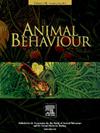信号和反应的地域差异:个体身份信号与 Polistes fuscatus 黄蜂种群的个体面孔学习能力有关
IF 2.3
2区 生物学
Q2 BEHAVIORAL SCIENCES
引用次数: 0
摘要
交流需要信号和接收者的反应,但当一个物种的识别能力在不同的地理范围内存在差异时,信号和反应如何共同作用,我们却知之甚少。以前的研究表明,来自美国密歇根州的 Polistes fuscatus 黄蜂具有个体人脸识别能力,而来自美国宾夕法尼亚州中部的 Polistes fuscatus 黄蜂则不具备这种能力。在这里,我们将对整个 P. fuscatus 分布区的信号和反应的种内差异进行更广泛的评估。我们量化了每个种群中可感知的面部图案变化量,作为个体身份信号的衡量标准。我们还测量了每个种群中的黄蜂如何准确地学会分辨一组标准的同种人脸,以此作为个体人脸识别的衡量标准。我们发现,黄蜂同样善于学习分辨来自其种群的黄蜂和来自不同种群的黄蜂的面孔,这证实了分辨一组标准面孔是衡量个体面孔学习能力的可比标准。我们发现,不同种群的黄蜂在信号和反应上存在显著差异,而且个体身份信号和接收器反应是相互关联的。与个体身份信号变化较少的种群的黄蜂相比,个体身份信号变化较多的种群的黄蜂能更准确地分辨出标准的同种人脸。总之,我们发现在个体身份信号和反应方面,种内地理变异程度之高令人惊讶。对更多分类群的研究对于评估信号表型和接收器反应是否在地理可变的通讯系统中存在普遍联系非常重要。本文章由计算机程序翻译,如有差异,请以英文原文为准。
Geographical variation in signals and responses: individual identity signals linked with capacity for individual face learning across Polistes fuscatus wasp populations
Communication requires both signals and receiver responses, yet we know little about how signals and responses covary when recognition capacity differs across a species' geographical range. Previous work has shown that Polistes fuscatus wasps from Michigan, U.S.A. are capable of individual face recognition, while P. fuscatus from central Pennsylvania, U.S.A. are not. Here, we provide a broader assessment of intraspecific variation in signals and responses across the range of P. fuscatus. We quantify the amount of perceivable facial pattern variation in each population as a measure of individual identity signalling. We also measure how accurately wasps from each population learn to discriminate between a standard set of conspecific faces as a measure of individual face recognition. We show that wasps are equally adept at learning to discriminate faces of wasps from their own population and faces of wasps from different populations, confirming that discriminating a standard set of faces provides a comparable measure of individual face learning capacity. We find that there is striking variation in signals and responses across wasp populations and that individual identity signals and receiver responses are linked. Wasps from populations with more variable individual identity signals learn to discriminate between a standard set of conspecific faces more accurately than wasps from populations with less variable individual identity signals. Overall, we find surprisingly high levels of intraspecific geographical variation in individual identity signals and responses. Work in additional taxa will be important to assess whether signal phenotype and receiver responses are commonly linked in geographically variable communication systems.
求助全文
通过发布文献求助,成功后即可免费获取论文全文。
去求助
来源期刊

Animal Behaviour
生物-动物学
CiteScore
4.60
自引率
8.00%
发文量
236
审稿时长
10.2 weeks
期刊介绍:
Growing interest in behavioural biology and the international reputation of Animal Behaviour prompted an expansion to monthly publication in 1989. Animal Behaviour continues to be the journal of choice for biologists, ethologists, psychologists, physiologists, and veterinarians with an interest in the subject.
 求助内容:
求助内容: 应助结果提醒方式:
应助结果提醒方式:


